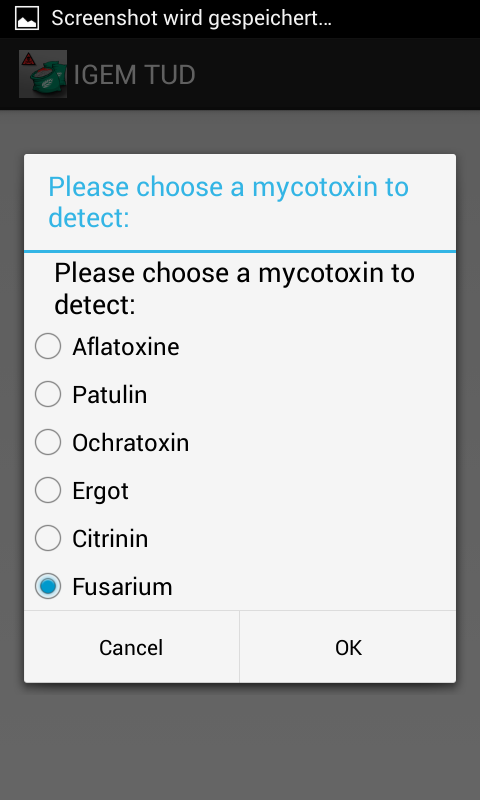Team:TU Darmstadt/result/electrical engineering
From 2013.igem.org
Electrical engineering
Handheld development:
Our handheld contains an Arduino Uno Rev3 microcontroler which is connected to a HC-05 bluetooth module.Two LEDs are connected over 100 ohm resistances to digital ports on the Arduino Uno. One of the LEDs emitts radiation with a wavelength of 450 nm permanently during the detection process. The other LED emmits light of a wavelength at 575 nm but works as a photo diode. Sensing details are explained below.
You can find our arduino code, open soure on the folowing site:
Mycotoxin Handheld Arduino code
Light emitting diodes are robust, low-cost, and energy efficient. LEDs cover an increasingly broad spectral range from UV to near infrared.
LEDs can be both light emitters and detectors. For example, a LED that emits greenish-yellow light at the peak wavelength of about 555 nm detects green light at the peak wavelength of about 525 nm and over the spectral width of 50 nm.
Almost every LED is capable to detect a relatively narrow band of wavelengths, with different
sensitivity. When a LED is subjected to light, they generate a backwards biased current proportional to the light striking the diode, typical about 50pA.
A precise measurement of the LED photocurrent is possible, using inherent capacitance of diode itself (typically picoFarads) and microcontroller I/O ports with configurable internal pull-ups states and built-in digital timer-counter.
Klick here for our mykotoxin detecor app App
YYYYYYYYYYYYYYYYYYYYYYYYYYYYYYy
Detection steps:
Step 1:
In the detector mode the LED is charged up to +5V very quickly (100-200μs), the charge is the sustained by the
inherent capacitance of the diode (typically 10-15 pF).
Step 2:
Thence,the pin P1 is switched into the Hi-Z input mode (approximately 1015 ohm resistance), “STEP 2”.
Under the reverse bias conditions, a simple equivalent-model for the LED is a capacitor in parallel
connection with a current source iR(Φ), which models the photocurrent, induced by the incident light
intensity Φ, Figure 2(b).
The leakage current iL through the pin P1 (usually 0.002 pA) is insignificant Sensors and their Applications compared
to a typical photocurrent iR(Φ) of 50 pA through the diode itself, under the normal ambient lighting.
Analytically considered, the discharging process of Cr can be expressed as:

LED Sensing:
App development:

Graph 1: "Screenshot from an smart phone display"

Graph 1: "Screenshot from an smart phone display"
Bluetooth communication:

Graph 1: "Bluetooth device"
References
- G.W.Mitchell and J.W.Hastings: A Stable, Inexpensive, Solid-State Photomultiplier Photometer
Biological Laboratories, Havard University, Cambridge, Massachusetts 02138
Analytical Biochemistry 39, 243-250 (1971) - Hanwen Yan: An Inexpensive LED-Based Fluorometer Used to Study a Hairpin-Based DNA Nanomachine
Staples High School, 70 North Avenue, Westport, CT 06880 USA - Nuts and Volts – November 2007
- Nuts and Volts – Mai 2013
- Forrest M. Mims III: Sun photometer with light-emitting diodes as spectrally selective detectors
The author is with Science Probe, Inc., 433 Twin Oak Road, Seguin, Texas 78155. Received 21 February 1992. © 1992 Optical Society of America - W J O’Hagan et al.: MHz LED source for nanosecond fluorescence sensing
Meas. Sci. Technol. 13 (2002) 84–91; Department of Physics and Applied Physics, University of Strathclyde, Glasgow G4 0NG, UK - Andrew E. Moe: Improvements in LED-based fluorescence analysis systems
Department of Electrical Engineering, University of Washington, Seattle, WA 98195-2500, USA - Radovan Stojanovic and Dejan Karadaglic: An optical sensing approach based on light emitting diodes
Journal of Physics: Conference Series 76 (2007) 012054
 "
"